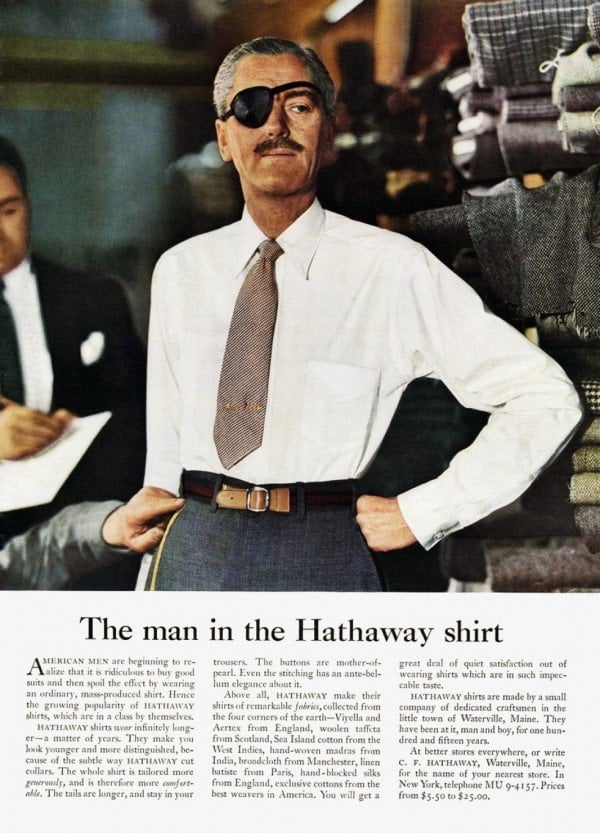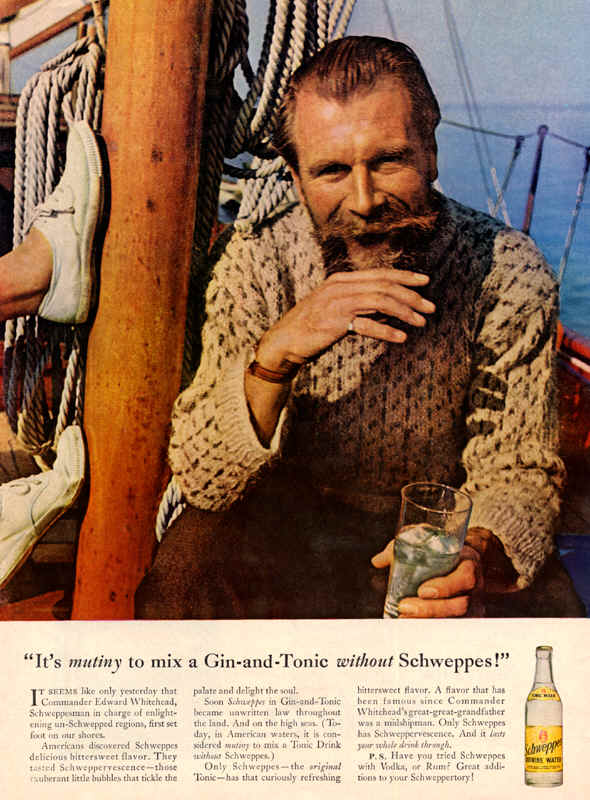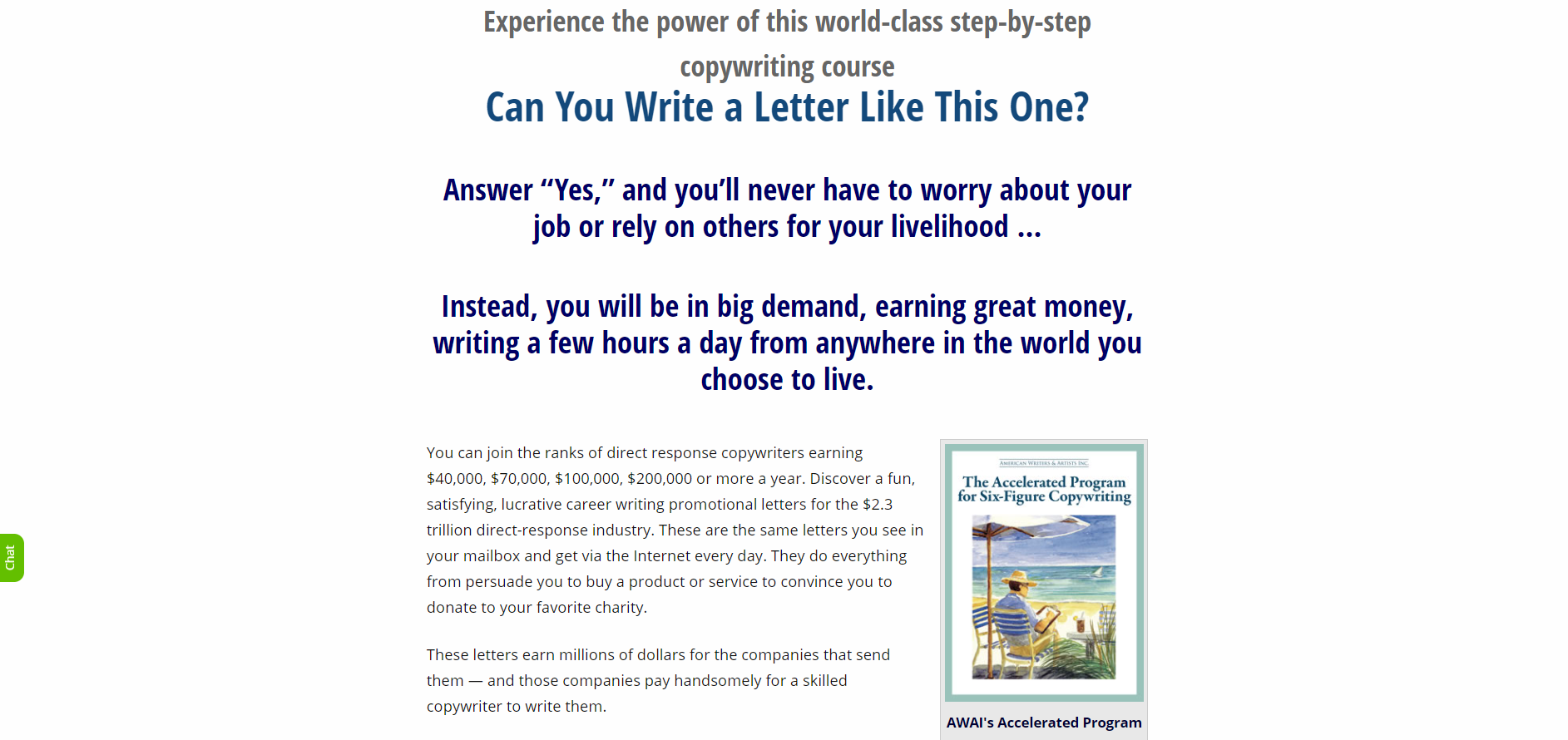Every word you write has emotion and meaning behind it.
Knowing how to use them combined with other strategies to generate millions of dollars is no easy feat.
The tip-top of the mountain in copywriting is direct response.
This is the highest-paying and most rewarding form of sales copy that can be written.
That’s why today you’re going to learn what direct response copywriting is and see real-life examples for inspiration if you keep reading.
What is direct response copywriting?
Direct response copywriting is the process of writing sales copy that has the goal of getting an immediate response from the customer.
This is one of the reasons why direct response is looked at so highly in the writing and business world. The writer themself is responsible for all of the sales and results generated by the copy.
It is also why direct response copywriting is so lucrative.
Let me give you an example.
Imagine you charged a client $10,000 for a landing page, and it generated $100,000 in sales. That’s a ten times return on their investment. Not bad!
Since the copy is as close to the point of sale as possible, it takes a very skilled writer to generate revenue, and projects are typically much more expensive.
Some examples of direct response material include:
- Landing pages
- Fliers
- Brochures
- Product descriptions
- Sales pages
- Email newsletters
- Advertorials
- Magazine ads
- PPC ads
- Etc
Any material that directly speaks to the consumer and prompts them to make a purchasing decision on the spot can be considered direct response copy.
Jasper has been an extremely useful tool when I’m writing any kind of direct response sales copy.
Now that you know what direct response is, let’s talk more about what the copywriters handling these projects do to complete them.
What does a direct response copywriter do?
Here are some of the steps that I personally take as a direct response copywriter that you can use to improve your own writing process.
These steps are relatively universal, and all copywriters will use them to some degree.
They study the hell out of the market and customer
A copywriter needs to understand the market and customer they’re writing for like the back of their hand.
This normally begins by interviewing the client to learn more about their product, target audience, and value proposition. I find that a single discovery call can give me enough information to work with for an entire project before I conduct my own research.
Very few copywriters do this, but I like to also contact other people within the company to learn more. These are typically product designers and marketing directors.
After the initial client call, a copywriter will research the industry they’re writing for through market reports, case studies, whitepapers, and similar resources.
These allow the writer to learn more about industry trends, consumer behaviours, and research competitors.
Next, the copywriter will analyze the buyer’s persona for the project. They will study their demographics, pain points, questions, and objections.
This is perhaps the most important part of writing sales copy.
When you know the customer on a very deep level, you are able to speak in their language, bring up emotions they’re feeling, and relate to their experience.
All of this will make them more likely to buy the product when it’s positioned as the cure for their problem.
This is normally done through surveys, scanning social media, reading product reviews, and snooping on forums.
The last step in the organization process, before writing begins, is to determine what makes the product so special.
A copywriter will list out the unique value proposition, why it’s worth its price point, features, benefits, and more.
This brings me to my next point.
They write drafts, edits, and revisions
After the copywriter’s desk looks like the office of a private detective with documents everywhere, they will begin writing.
A draft of the copy is the first initial goal.
It won’t be clean. It won’t be perfect. But it will have a general idea of where the copywriter wants to take it.
This is when it’s handed off to the client for ideas for revisions.
The copywriter will then revise the copy until it aligns with the goal of the project, the company’s brand, and looks cleaner than a Ferrari.
I personally like to go back through the content and ensure that all of the sections flow in a logical order, as well.
While the body of the copy may be completed at this point, there’s still one very important section to write…
The headline.
They find the perfect headline
Famous copywriter and father of modern advertising, David Ogilvy, once said that the headline is 80% of your work as a copywriter.
It’s true.
Most people will read the headline of a piece of content and never go deeper than that.
If you write boring headlines, your bank account will look quite boring, too.
It’s not uncommon for copywriters to spend half of their time writing headline ideas, erasing them, and trying out new ones.
There are some tried and true headline strategies that they’ll use, such as:
- Urgency: Writing a headline that makes the customer feel like they need to take immediate action or they’ll miss out on a great deal.
- Unique: A headline that stands out from the crowd and makes the customer intrigued to learn more.
- Ultra specific: Vague headlines don’t tell the reader anything. This is why it’s much more effective to use precise numbers and information, so readers know what to expect within the copy.
- Calls to action: Phrases that tell the reader to click through, flip the page, read the copy, etc.
- Questions: Using a question the audience has asked within the headline relates to their experience and makes them interested in reading the copy.
There are dozens of more strategies writers use when crafting headlines, but those are some of the common approaches.
Let’s look at some examples of direct response copy next.
How Do I Start Direct Response Copywriting?
Starting in direct response copywriting involves a few key steps. First, immerse yourself in the principles of direct response marketing.
This involves understanding how to craft compelling copy that drives immediate action, whether it’s a sale, a sign-up, or any other specific response.
- Learn the Fundamentals: Begin with books and courses on direct response copywriting. Focus on understanding customer psychology and persuasive writing techniques.
- Practice Writing: Develop your skills by practicing. Write sample pieces, like email campaigns or landing pages.
- Build a Portfolio: Create a portfolio showcasing your work. This can include both your practice pieces and any client work.
- Find Clients: Start pitching your services. Use platforms like LinkedIn, freelance websites, and directly reach out to businesses that use direct response copywriting.
- Continuously Learn and Adapt: Stay updated with trends and continuously refine your skills.
What is the Difference Between Brand and Direct Response Copywriting?
The key difference lies in their objectives and writing style:
- Brand Copywriting is about building and maintaining a brand’s image and voice. It’s less about immediate sales and more about long-term customer relationships, brand recognition, and emotional connections. Brand copywriting is often seen in content marketing, social media, and traditional advertising.
- Direct Response Copywriting is focused on eliciting an immediate response or action from the reader. It’s highly targeted, with a clear call-to-action (CTA), and is often measurable in terms of response rate and effectiveness. This type of copywriting is common in email campaigns, sales pages, and online ads.
How Much Do Direct Response Copywriters Make?
The earnings of direct response copywriters can vary widely based on experience, skill level, and the industries they serve.
As of my last update, entry-level copywriters might start around $30,000 to $50,000 annually, while experienced copywriters can earn upwards of $100,000 or more, especially when including profit-sharing from successful campaigns.
Highly successful direct response copywriters, particularly those who work with big clients or who have specialized in lucrative niches, can earn significantly more.
Is Direct Response Considered a Copywriting Niche?
Yes, direct response copywriting is indeed considered a niche in the broader field of copywriting. It requires a specific set of skills focused on creating copy that drives immediate action.
This niche is particularly valuable due to its direct impact on sales and measurable ROI, making it a sought-after skill in various industries, especially in online marketing, e-commerce, and fundraising.
Direct response copywriting examples
Here are some examples of direct response copy and lessons you can apply to your own projects.
The Hathaway shirt

This is one of David Oglivy’s most famous ads. It was an advertisement for the designer brand Hathaway and a new line of shirts they released.
It featured the iconic man with an eyepatch who wore the dress shirt being advertised.
Ogilvy once commented that his agency strategically used this character to spike curiosity and made the reader dive into the copy to figure out who this man was.
It was a copywriting trap.
Great copywriters like David create a slippery slope in which every sentence leads perfectly to the next until the very end, where a sale is made.
While the image acts as a sales message in itself, the body of the ad is where the real magic happens.
Read the copy, and you’ll notice that it continually speaks about the amazing benefits of wearing a Hathaway dress shirt. This includes its comfort, ability to match any outfit, and how it gets little to no wrinkles.
It elaborates on the high-quality materials sourced from all over the world that achieves these effects, as well.
The last paragraph ends with a call to action to purchase the shirt along with its price range.
Schweppes

Who doesn’t love a nice mixed drink in the summer weather?
That’s exactly what David Ogilvy thought when he wrote this ad for Schweppes.
The ad featured a gentleman holding a mixed drink while aboard a boat with the copy making puns around the brand’s name.
It said things like “un-Schwepped regions” and “Schwepperman” when describing Commander Edward Whitehead, a character made up for the ad.
This story and persona added depth to the ad and are known as an anchor or concept in copywriting.
David took an ordinary drink and aligned it with a made-up character. This made the advertisement much more interesting, along with its corny joke.
This is a great example of how an advertiser can take an everyday product but promote it in a unique way that attracts attention.
AWAI’s copywriting course

Using a copywriting course’s landing page as an example of good copy…
Inception.
Jokes aside, the American Writers & Artists Inc page for their six-figure copywriting course is a great resource to swipe.
The page uses bold headlines with questions, calls to action, and statements that resonate with readers.
It’s not outrageous to think that many people aspiring to work for themselves fear for their job or livelihood when it’s in the hands of a boss.
That’s exactly why mentioning that in the third headline is so powerful.
The fourth headline states the benefits of taking the course, which is making a great living from anywhere in the world as a writer.
The landing page goes on to list ten reasons writers should take the course, and it ends with three different calls to action.
One is for purchasing the course, learning more, and logging in for existing customers.
How to become a direct response copywriter
Now that you understand what a direct response copywriter does, you may want to become one yourself. Good choice.
Direct response copywriting is a ton of fun and easily the most lucrative form of writing.
Here are the steps you need to take if you wish to pursue it as a side hustle or full time career.
Step 1: Study copywriting like your life depends on it
You can’t be a good copywriter without sharpening your axe.
That means you must dedicate time every day, or at least on a consistent basis, to studying the best copywriters in the world.
I’ve written a few articles on copywriters and advertisers that you need to read with that being said:
- Don’t Write Any Copy Until You Know These 10 Claude Hopkins Advertising Strategies
- 7 Copywriting Strategies From Joseph Sugarman That Will Make You 10x The Writer
- David Ogilvy Copywriting Strategies Every Writers Need to Know
These blog posts cover the main strategies these legendary writers used to create some of the best campaigns of all time.
Besides this, you should also read the main copywriting books like:
- The Adweek Copywriters Handbook
- Scientific Advertising
- Confessions of an Advertising Man
- Breakthrough Advertising
- The Boron Letters
You want to understand all of the fundamental strategies of writing copy, emotional triggers, and the psychology of marketing in general.
All of these elements will allow you to write copy that gets people glued to the screen (or paper) and ultimately buying from you.
You can also enroll in my copywriting training to get mentorship and feedback from me while mastering how to write copy.
Step 2: Put together a portfolio
Once you’re confident in your understanding of copywriting, it’s time to piece together a piece.
And I know what you’re thinking.
You have no previous experience in copywriting and nothing to show. Let’s change that.
Compile any material you’ve written for school, work, or as a hobby together in a Google Drive folder or on a personal website.
Trust me, you have to have something that shows off your writing ability.
In either case, I also suggest that you write up some mock sales letters, blog posts, and other material.
Create a fictional product, topic, or business to base these on. Skill is skill. Just because it isn’t published doesn’t mean you aren’t a talented writer.
This brings us to the last step.
Step 3: Pitch prospects directly
We’re talking direct response copywriting, so it only makes sense to go directly to publishers.
Yeah, there are writing job boards and long-term strategies for getting clients, like content marketing, but you want work now, right?
That’s why you should begin Googling keywords for a specific industry and looking for who advertises.
Turn off Adblock if you have it. Otherwise, you won’t be able to see any of the display ads. You can tell which listings are ads via the small green “Ad” flare like this:

Save a list of these websites in a spreadsheet. Go easy and start with roughly a dozen to not overwhelm yourself.
Then, go one by one and visit their website to find a contact form or email.
Send them a personalized pitch with the following template afterward:
Good afternoon,
I really like what you’re doing with {Innovation/Product/Etc}.
I found {Company name} through one of your Google ads so I wanted to reach out.
I’m a direct response copywriter and was curious if you neded any help writing promotions or content at the moment.
Feel free to check out my work here: {Url}.
Warm regards,
{Your name}
I’ve used cold emailing like this to land some of my biggest clients, and trust me when I say that simplicity works best.
Don’t send emails that are three paragraphs long and all about you. If you can’t sum up your pitch and idea within 2-3 sentences, don’t send the email yet.
Follow up every few days until you get a response since companies and executives in charge of advertising/marketing are regularly busy.
Final thoughts on direct response copy
Direct response copywriting is where all of the money is in writing.
It is the process of writing copy that customers directly respond to, such as brochures, direct mail, or a landing page.
You can make a great living writing blog posts and other material for clients, but advertisements are the best in terms of earning potential.
On the flip side, companies shouldn’t be afraid to dish out large capital to hire a good writer because the ROI can be enormous.
Or enroll in my courses to master copywriting and grow a writing business.
What’s your experience so far with direct response copy?














